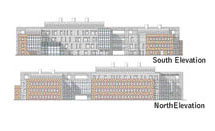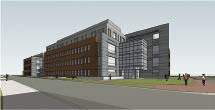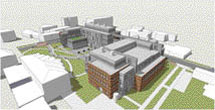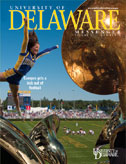Building enthusiasm for science, engineering




ON THE GREEN | In 1810, German educator and philosopher Wilhelm von Humboldt wrote, in his now-famous prescription for the future University of Berlin, that “universities should treat learning as not yet wholly solved problems and hence always in research mode.”
If Humboldt were still alive, he would undoubtedly be pleased with the plans for the new interdisciplinary science and engineering building that will be constructed at UD with donor support. With a goal of engaging students and stimulating excitement about science and engineering, the new building is being designed to be dynamic, dramatic and distinctive, while providing badly needed classroom and lab space for a growing number of engineering students.
The 194,000-square-foot facility will be a place where teaching, learning and research come together in an integrated way, with the research providing content for the curriculum and with students learning through exploration of real-world problems, according to architects Ayers/Saint/Gross of Baltimore.
To be located at Lovett Avenue and Academy Street, the building will include classrooms and teaching laboratories, core research facilities for teams of researchers and space for the University of Delaware Energy Institute and the Delaware Environmental Institute (read story).
University President Patrick Harker has referred to the planned facility as “our most critical need,” while former UD Board of Trustees chairman Howard Cosgrove says that it is “key to attracting the most talented new students, supporting research and fostering the scientific innovation that is needed by our state and our nation.
“By enhancing our strengths in renewable energy and environmental research, and by encouraging interdisciplinary collaboration, this new lab is vital to the University’s future,” Cosgrove says.
The building’s design reflects the University’s vision for its use. “A great deal of this building is about engagement—of diverse ideas and a variety of disciplines,” says Michael Chajes, dean of the College of Engineering. “And, when you look at the floor plans and how the building is situated on the site, you can see these obvious opportunities for collaboration.”
In newly structured science classes, students will learn fundamental scientific principles in broad-based courses that encompass biology, chemistry and physics. They will then apply those principles to solve problems in such areas as renewable energy and stewardship of the natural environment.
“The space is meant to blur the lines between disciplines,” Harker says, “and to tear down the walls—literally and metaphorically—between instruction and research, so that the research being conducted in one lab provides the content for the curriculum being taught next door.”
George Watson, interim dean of the College of Arts and Sciences and Unidel Professor of Physics and Astronomy, says the University wants “to elevate the level of discovery--be it in research or in teaching.” He sees problem-based learning (PBL) as an effective route to that goal and the new building as providing the perfect environment for implementing an integrated science curriculum using PBL.
With classrooms and instructional laboratories side-by-side in the facility, students will move freely back and forth between the classroom and the lab in small groups, Watson says, leaving behind a world where lectures are delivered in large auditoriums and where lecture content and lab work are sometimes out of synch.
“PBL is about the real world,” he says. “The problems that need to be solved don’t fall into neat disciplinary areas, nor do students think that way.”
In a PBL approach, students are presented with a problem and then work toward a solution with their colleagues, potentially stimulating debate and enriching their view of the concepts and issues involved.
Watson and Chajes emphasize the importance of integrating policy into both instruction and research on energy and the environment. “If students are to make informed decisions about the applications of science and engineering, they need to do it from a position where they’re informed about the social, economic and political implications of those decisions,” Chajes says.
Another novel aspect of the building is that several classrooms will be dedicated for use in teaching courses not related to science or engineering.
“Our hope is that the building will be a social and intellectual hub,” Watson says. “We want everyone to come in here and get excited about science and engineering.”
Article by Diane Kukich , AS ’73, ’84M





